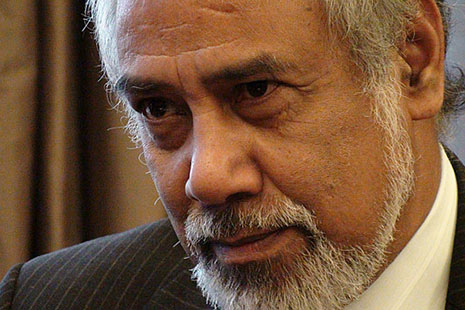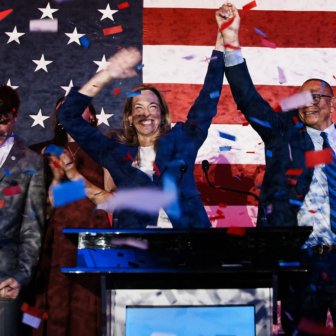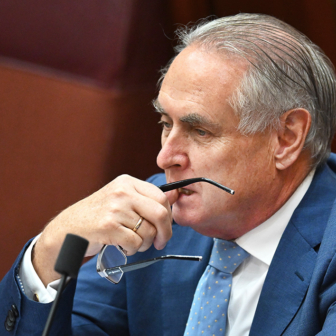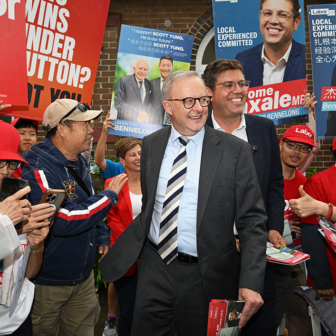CAMPAIGNING began this week in Timor-Leste for the parliamentary elections on 7 July. In the country’s semi-presidential system, where executive power is overwhelmingly weighted towards the prime minister, this is the most critical of the three elections in 2012. Twenty-one parties will hit the hustings, competing for seats in the sixty-five-seat national parliament. Barring a sensational performance from one of the major parties, Timor-Leste’s proportional electoral system makes a post-electoral coalition the likely outcome. Many of the smaller and newer parties will fail to meet the 3 per cent threshold required to gain seats, a feature designed to limit the fragmentation of the party system in the interests of stability.
Much is at riding on a peaceful election. Should all go well, both the UN police and the Australian-led International Stabilisation Force will withdraw from the country from late this year. Timor-Leste’s two electoral bodies have now assumed primary responsibility for running elections, and the successful conduct of the two presidential elections, which saw the former military resistance commander and retired defence chief Taur Matan Ruak become the new president, was a significant and positive outcome. Widely respected by all parties – including Fretilin, the party of his second round opponent, Lu Olo – Ruak’s strong popular mandate of 61 per cent was a promising result for stability. It cemented part of the leadership that will steer the country beyond the past decade or more of ly assisted state-building.
But a successful and widely accepted result in the parliamentary elections is even more important for democratic consolidation, and the year ahead will be critical for the incoming government, whatever its complexion. Ruak has emphasised this point by declaring he will not travel overseas in his first year of office: an extraordinary commitment for a head of state, and one which suggest exactly how much is at stake ten years after independence. As the East Timorese NGO Fundasaun Mahein has pointed out, many Timorese will lose their jobs upon UN withdrawal, and that will bring a heightened potential for political instability.
SINCE 2007, Timor-Leste has been governed by the Alliance with a Parliamentary Majority, or AMP, a coalition of parties headed by the current prime minister, Xanana Gusmão. Fretilin, which formed the first post-independence government from 2002, presently serves as the opposition. Though there is little in the way of polling, the major election issues are clear. Management of the country’s now $10 billion petroleum fund, and associated development policies, will be a key focus. With memories still fresh of Timor-Leste debilitating political-military crisis of 2006, preserving peace and stability will be another.
On peace and stability, the record of the AMP government since 2007 has been positive. It has successfully dealt with two bitter legacies of the 2006 crisis: the 150,000 internally displaced people living in camps in Dili, and the 600 army “petitioners” whose sacking from the military triggered the crisis. Because the country’s turbulent political history leads even the most disengaged voters to place a premium on peace and security, the electoral significance of these achievements should not be underrated.
The AMP’s performance on development issues has been more mixed. Some headlines indicators have certainly been positive: annual economic growth is close to 10 per cent, although it has been driven almost exclusively by government expenditure of petroleum fund revenues, and there have been further advances on the primary health and education gains made by the first FRETILIN government. Infant mortality rates fell by a third between 2004 and 2010, and maternal mortality rates more than halved, though both remain a concern. The national literacy rate remains a problem at 50 per cent, though it is improving substantially among younger Timorese. Although the official poverty rate has dropped from 50 per cent to 41 per cent since 2007, the UN special rapporteur on extreme poverty suggests the situation is worse, with 68 per cent suffering “multiple deprivations with respect to education, health and standard of living,” some 75 per cent of rural Timorese trapped in entrenched intergenerational cycles of poverty, and 58 per cent of children suffering from malnutrition.
The government has taken a distinctive approach to these challenges, arguing that spending above the “estimated sustainable income” generated by Timor-Leste’s sovereign wealth fund is necessary to kick-start development in the country. But critics have argued that vast expenditure of petroleum revenues – some $3 billion since 2007 – has disproportionately benefited a small group of Timorese in Dili, exacerbating inequality and inflating the prices of consumer goods and essentials. Though electricity provision has improved, the system remains unreliable, and popular perceptions hold that roads and bridges in the country are yet to show improvement. Indeed, former alliance partners like PSD leader Mario Carrascalão argue publicly that the results do not reflect the quantity of revenue spent, and East Timorese NGOs like La’o Hamutuk have expressed repeated concerns over the fund’s sustainability for future generations if spending continues at this rate.
The awarding of large contracts under the referendum and infrastructure funds has also generated allegations of an increasing culture of corruption in public life. The current trial of the justice minister Lucia Lobato is the most high-profile case. Others argue that too little has been invested in alternative industries to avoid the “resource curse,” especially in agriculture, where national performance appears to be declining rather than improving. For its part, the government released an ambitious National Strategic Development Plan for 2011–30 which outlines the goals of economic diversification for the future, and has also set up an anti-corruption commission.
A smaller but nonetheless significant issue concerns a pilot program to teach initial literacy to primary students in their home language in districts where the co-official language, Tetun, is less widely spoken than other Timorese languages. The plan is backed strongly by Kirsty Sword Gusmão, but a number of domestic critics have attacked it as likely to undermine national unity, arguing that all should learn in the official languages from the start of their school years. Though such reservations may seem understandable at first blush, research strongly suggests that initial literacy in the home language would ultimately make these students more adept at both Tetun and Portuguese, and achieve that result more quickly.
EIGHTEEN parties and three coalitions will contest the July elections. Though it finished second in 2007 with 24 per cent of the vote, Xanana Gusmão’s CNRT – the National Congress for Timorese Reconstruction – has been the lead party in the governing coalition, alongside the smaller ASDT–PSD (a coalition of the Timorese Social Democratic Association and the Social Democrat Party) and the Democratic Party. The CNRT has several electoral advantages – most notably its high profile leader, Xanana Gusmão, and his alliance with the popular new president, who this week made of point of saying the AMP had governed well in its term. The CNRTs decision to back Ruak – the only major party to do so formally – seems to have paid strategic dividends. The party is mounting a serious campaign, with an ambitious goal of winning forty-five seats, and have reportedly amassed a potential US$2 million war chest from national and supporters to bankroll it. Questions have been raised about whether these breach Timor’s prohibitions against corporate electoral donations. Although the National Electoral Commission has declared compliance with the electoral law, a definitive reading on this point can only be rendered by the courts.
A potential challenge for the CNRT is a level of popular discontent with rising inequality and the limited development progress in the rural areas. With the powerful combination of two former Falintil commanders, Gusmao and Ruak, some in Dili fear the campaign could take the form of the “domestic and military resistance” against the “diplomatic front and diaspora,” creating a form of insider/outsider narrative. Though both groups were essential to the achievement of independence, and are in fact represented across the political spectrum, there are certain strains of popular resentment in Timorese society that could respond to such a theme.
For its part, Fretilin – still the largest single party – has a lot at stake in this election. A second term in opposition would damage the historic party. Fretilin’s advantage is a well-organised district structure, a committed membership base, a level of popular disaffection with development and inequality in the districts, and clear tensions within the AMP coalition in recent years. Despite some unhelpful rhetoric about the AMP being a “de facto” government, the party has generally performed well as a democratic opposition. This has made its own significant contribution to peace and stability in Timor-Leste. It is also true that Fretilin’s vote recovered considerably in the western districts in the presidential elections – offset by Ruak’s own good performance in the eastern districts.
Fretilin has staked a lot on plans to rein in corruption, but this issue may not pay great electoral dividends. A study by the East Timorese Anti-Corruption Commission found that while many are concerned about the issue, it “barely registers” when set alongside issues like unemployment, poverty, and political instability. Moreover, some 52.5 per cent of respondents indicated they did not know what corruption was. While these figures vindicate the commission’s emphasis on popular education, they raise some questions over the Fretilin strategy. However, while some commentators question whether the party has renewed its image sufficiently to capitalise on tensions within the AMP – and others wonder about the lack of an obvious leadership succession plan – the more important question is probably a different one: can Fretilin articulate and sell an alternative plan for national development during the campaign? A well-run campaign which places human development at the forefront could yet see Fretilin set the 2012 campaign alight.
Looking at other parties brings us to the wild card in this election: the former president and leader of the diplomatic front, Jose Ramos-Horta. As he signalled in March, Horta is participating actively in the parliamentary elections. He brings an important reputation as a bridge builder, and the only historic leader to emerge from the 2006 crisis on speaking terms with all sides. On the other hand, the political alliance forged between Horta and Gusmão in 2007 has since broken down, with the former president an outspoken and often critical commentator on issues of government performance and transparency in his final year in office. It is clear there is little love lost between the two key historic figures.
Horta has since thrown support behind the Democratic Party, or PD, led by the president of parliament and former clandestine resistance leader Fernando “Lasama” de Araujo, which has its support base among a younger generation of independence supporters educated in the Indonesian era. The PD underperformed in 2007 with 11 per cent, despite the better performance of its leader in the presidential races, and is also hampered by divisions between key leaders from the east and west of the country.
However, the PD has been considerably boosted by the support from Ramos-Horta, who received a solid 18 per cent of the 2012 presidential vote despite the lack of support from any major party. Notably, though, Horta has not joined their list of candidates, despite considerable efforts from PD to persuade him to plant his flag; nor has he joined the party. Indeed, it may come as no surprise if he also lends active campaign support to ASDT and Fretilin. While campaigning with more than one party will help Horta conserve his bridge builder image, this also points to a wider strategy. He has publicly signalled the desire to have Fretilin included in the next government, as a means of unifying the east and west of the country. It seems reasonably clear that Horta’s strategy is to help build up both PD and Fretilin – along with ASDT – to increase the chances of forging a coalition against CNRT.
IF Ramos-Horta’s intentions are reasonably clear, Lasama’s are less so. Though there is little doubt he and some other PD leaders are open to a new alliance and known to be frustrated with their lack of policy input to the AMP government, a greater question mark hangs over Lasama’s ability to take a divided party along with him. At least one senior leader, Mariano Sabino, is more firmly in the pro-CNRT camp. While Ramos-Horta’s participation could help sell such a move to an uncertain membership base, the outcome cannot be assumed. Either way, given Ramos-Horta’s personal following, if PD can reconcile their internal differences then they could perform well in this election, emerge as the new “third party,” and potentially become the kingmakers in July.
One important recent development is the split in another AMP party, the Timorese Social Democratic Association, or ASDT. Not long after the death of the party’s founder, Xavier do Amaral, the party held a fiery congress that resulted in a major split, and two separate party lists being submitted to the National Electoral Commission: one from Gil Alves, the AMP tourism minister, known to be strongly pro-CNRT; the other from João Correia, whose faction sought to make Ramos-Horta honorary president of the party. In a potentially significant development, the “Correia list” was last week found by the courts to be the lawful ticket, on the basis they were the only group to formally convene the required party congress. The potential for four or five seats to go to a party with close links to Ramos-Horta adds another level of intrigue to this election, though the larger issue could be how ASDT survive the passing of their much loved founder.
The same must be said of the Social Democratic Party, or PSD, whose founder, a former governor of the territory in Indonesian era, Mario Carrascalão is in ill health and not on the party list. Even he has publicly criticised the PSD’s decision to place Lucia Lobato – currently embroiled in a corruption trial – second on their list. In addition, the party has lost key members, including one of its co-founders, Fernando Gusmão, who has formed a new party, the National Development Party. While the PSD would generally be assumed to side with CNRT over Fretilin, and this may still prove the case, PSD itself insists it will be open to all options. The ongoing public disputes between Gusmão and Carrascalão appear to lend this stated position some credibility.
Finally, the National Unity Party and its impressive leader Fernanda Borges may hold their three seats. If they can expand their vote the previously neutral party could have a say in final outcome. A range of new parties will test their luck, and though the 3 per cent threshold will see many of them ineligible for seats.
DESPITE the parties’ campaign bravado, it is most unlikely that any will secure a majority of thirty-three seats. This raises the issue of coalition-building. The CNRT can likely rely on whatever seats the small veteran’s party, National Democratic Unity of Timorese Resistance, gains; as can Fretilin on the small Democratic Alliance coalition – though either could fail to get the two seats they won last time. Beyond this, party dispositions are far less certain than they were in 2007. There are three clear possibilities.
The first is an AMP mark two, based around CNRT and smaller parties. If Fretilin’s second round presidential election vote of 38.8 per cent is taken as a benchmark, then this is strong possibility, albeit with smaller margin for error than in 2007 (when Lu Olo got 30.8 per cent). But treating Ruak’s second round vote of 61 per cent as an “anti-Fretilin” vote involves several assumptions about voter motives for supporting one of Timor’s greatest resistance heroes, not least that no Fretilin voters supported him – which, given his strong showing the eastern districts, seems a risky one. And despite CNRT’s support, Ruak ran formally as an independent, and some voters are likely to have valued that quality above all else in their head of state. It is also worth noting that more than 10 per cent of those who voted for eliminated first round presidential candidates abstained in the second round: suggesting some 4–5 per cent of the entire electorate could support neither Ruak nor Lu Olo. To the extent that this group has significance, they strengthen the independent hand of third party leaderships. Finally, if a corollary assumption was made to take Ruak’s first round vote of 25.7 per cent as a proxy for the CNRT vote in July, it would suggest that it has hardly grown since 2007. But neither of these seems a safe assumption: indeed it is more likely that both CNRT and Fretilin will improve on their 2007 votes at the expense of smaller parties, and that some (uncertain) percentage of second-round Ruak voters – along with second round abstainers – are amenable to a range of coalition outcomes.
The second possibility is a coalition based on Fretilin, potentially forged with Horta’s assistance, involving the ASDT and others. There is no question that Horta’s assistance could make Fretilin a more appealing prospect for alliance-making, should he choose to take that path. Horta’s own voter base is almost exclusively in the west, and his record as a bridge-builder, and credibility among western-based parties, is considerably greater the Fretilin’s own. The potential for PD to join is real, though somewhat fraught by their internal divisions, and this would strongly test Lasama’s leadership of his party. The sticking point in this scenario could be the choice of prime minister. One of the tempting possibilities in this contest is whether Ramos-Horta could emerge as the compromise PM candidate in this situation. This might make this alliance scenario far easier for some western-based parties to contemplate than many currently imagine.
Lastly, there is the outlier possibility of a grand coalition between Fretilin and CNRT. Though widely rumoured in Dili, it has the sense of a last resort. Nonetheless, both parties appear to be genuine when they say they are not closed to the idea, and there is reported to be some grass roots support. Discussions have certainly taken place, though no particular inference can be drawn from this. Such a combination could see Gusmão’s natural strengths in defence and security combined with Alkatiri’s in the economy and development – though the issue there would again the choice of PM, with no compromise candidate in sight. Though Gusmão and Alkatiri’s personal relationship is in fact far healthier than their combative political history suggests, this will count for little in the big game of agreeing on prime minister. Indeed, to label this particular problem a sticking point would be an understatement.
While this may make the election sound as if it will be all about horse-trading and elite post-electoral deals, the truth is the outcome will also come down to votes. It is one thing to exclude a leading party with 29 per cent of the vote, as in 2007. But if CNRT or Fretilin (or indeed, PD) can increase their vote share to the mid-30s, the case for forming an opposing coalition of smaller parties becomes harder to make. In the high-30s it becomes nearly impossible, as smaller parties can easily be persuaded to break off in return for ministries, and increasingly nervous that others will do so first. Certainly, CNRTs aim appears to be to do well enough that coalition partners select themselves.
THE fact that a range of coalition options are being actively discussed is a good sign of party system evolution, but also of mature politicking in an absolutely critical election for the East Timorese state. There could not possibly be more at stake as security and state-building forces prepare to depart in late 2012. A coalition government that embraces eastern and western based parties might well be a prudent solution, though it should be noted that the presidential election saw regionalised voting patterns from 2007 normalise to some degree, with the Fretilin vote recovering considerably in the west, and moderating somewhat in the east. If this pattern were replicated in the parliamentary elections it would be a welcome sign that another difficult political legacy of the 2006 crisis is passing.
Above all, Timor-Leste’s often fractious political elites will have to play the long game in the wake of this election. As the United Nations departs for the second time, another crisis cannot be contemplated, by any parties under the long fought for flag of the Democratic Republic of Timor-Leste. While some parties are asking for votes on their basis of their ability to guarantee peace and stability, this should instead be guaranteed whether or not they receive votes. For at least one substantial party, 2012 will bring defeat. But whoever ends up in opposition will share in the long term victory for the young state: for they will play a critical role in setting the tone for democratic consolidation beyond the UN era. There is little doubt the new president Taur Matan Ruak will play a key role in emphasising these points after 7 July. •




